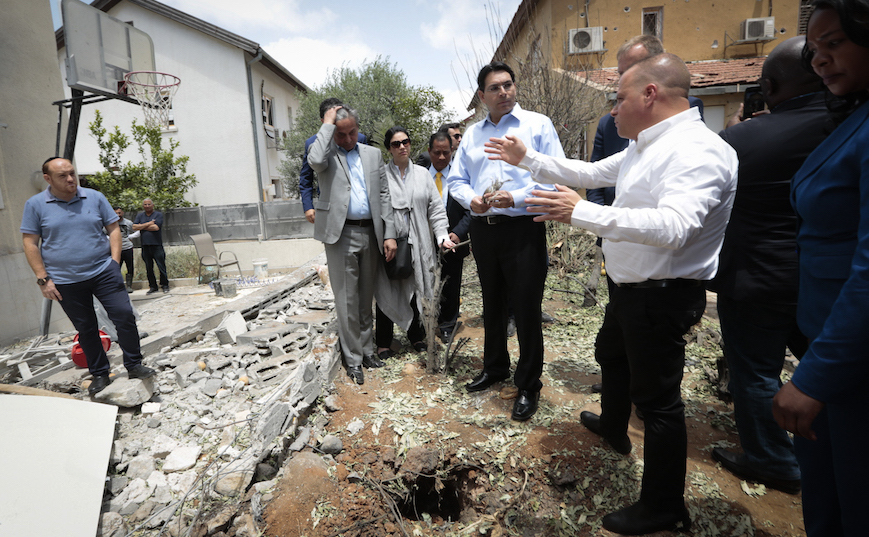Iran Sponsors New Round of Violence as Israel Goes Back to the Polls
Heavy violence erupted early May 2019 between Israel and the Hamas and Islamic Jihad regimes in Gaza. Four Israelis were killed and dozens injured by projectiles fired from Gaza. Those killed included Moshe Agadi, a father of four who died after a rocket slammed into his home in southern Israel early Sunday morning 5 May, 2019. During two days of intense conflict, around 25 people were killed in the Gaza Strip, including several Hamas and Islamic Jihad terrorists. This new round in the ongoing conflict between Israel and the Islamic regimes in Gaza was part of Iran’s ongoing promotion of terror in the region.
On 15 May 2019, Palestinian Arabs in Gaza commemorated the so-called Nakba Day, the annual commemoration by Arab countries of what the Palestinian Arabs call Nakba (Disaster), the founding of the State of Israel and the creation of the Palestinian refugee problem.
During the Nakba commemoration, Hamas and Islamic Jihad again vowed to continue the violent struggle against Israel. The two Gaza-based terror organisations organised a new violent mass-protest along the border with Israel in Gaza and again launched incendiary balloons which caused at least nine fires in southern Israel.
The Israeli military foiled a number of infiltration attempts and used riot control measures against the violent protesters wounding 60 of them.
Leaders of Hamas and Islamic Jihad, vowed to fight Israel until the “liberation of all of Palestine from the (Mediterranean) Sea to the (Jordan) River.”
This not merely rhetoric as we will see. One could argue that the Palestinian Arab terror organisations have already been trying to destroy Israel for more than 70 years and that all attempts by Hamas and Islamic Jihad to realise their goals have utterly failed.
However, something has changed over the past two years.
Since the beginning of the so-called ‘Great March of Return’, the violent Palestinian mass-protests along the Israeli border in March 2018, Hamas and Islamic Jihad attempted eight times to drag the Israel Defense Forces into a new war by launching hundreds of rockets at southern Israel.
At the beginning of November 2018, the parties came close to all-out war when Hamas and Islamic Jihad fired 460 projectiles into southern Israel destroying a complete building in the coastal city of Ashqelon which was levelled by an Iranian missile. The missile was a copy of the Iranian Falaq-2 and was assembled by Islamic Jihad in Gaza.
The mini-war began with an attack by a Kornet anti-tank missile on a bus which had transferred a group of IDF soldiers to the Gaza-border. Only one soldier was injured by the missile which had been supplied by Iran via its Lebanese proxy Hezbollah, according to the Meir Amit Intelligence and Terrorism Information Center in Israel.
Hezbollah leader Hassan Nasrallah later confirmed that his organisation had delivered the Kornet missile to the Palestinian terror organisations in Gaza.
At the beginning of May 2019, the same scenario came into play when Islamic Jihad snipers wounded two Israeli soldiers who were guarding the border with Gaza. That incident set off a new missile mini-war after the IDF responded by targeting Hamas and Islamic Jihad related targets in Gaza.
When the parties reached an unofficial ceasefire in the early hours of 7 May, 690 missiles had been fired on Israeli cities as far as Beit Shemesh 20 kilometres west of Jerusalem and the port city of Ashdod south of Tel Aviv.
It later became clear that Hamas leader Yahya Sinwar and Islamic Jihad leader Ziad al-Nakhala had ordered the missile onslaught at the very time they were in Cairo to discuss a new long-term Hudna (tactical ceasefire) with Egyptian mediators.
Both leaders have strong ties with Iran and reportedly take their orders from Qassem Soleimani, the shrewd commander of the Quds Force of the Iranian Revolutionary Guards Corps. The Quds Force is tasked with exporting the Islamic Revolution to other countries in the Middle East and beyond and is supporting and directing a number of proxies such as Ansar Allah (Houthis) in Yemen and the Hashd al- Sha’abi umbrella organisation of predominantly Shiite militias in Iraq. Sinwar was also responsible for reconciliation between Hamas and Iran in October 2017 and later openly confirmed Iran was the main sponsor of the Palestinian terror groups in Gaza.
The reconciliation became necessary after the Iranians significantly reduced their aid to the terrorist organisation over Hamas’ initial backing of Sunni Islamist rebels in Syria who tried to overthrow the Assad- regime. Egypt has a vested interest in calm in Gaza since it is still struggling with an insurgency by ISIS-inspired Islamists in the Sinai Peninsula.
Iran, on the other hand, has no interest in a lasting ceasefire in Gaza since it wants to drag the IDF into the Gazan mud to open a multi-front missile war against Israel.
Former Israeli national security adviser Ya’acov Amidror later confirmed that Iran was behind the serious escalation in southern Israel at the beginning of May. For this reason, the IDF decided to assassinate the so-called ‘money man’ Hamed Ahmed Abed Khudari a Hamas terrorist, who was responsible for the transfer of Iranian funds to the various Palestinian terror groups in Gaza.
It later became clear that Iran’s proxy Islamic Jihad in Gaza – also called Quds Brigade- had tried to drag Israel into a new Gaza-war and that its operatives formed the bulk of the terrorists killed by the IDF.
The more than 290 Israeli airstrikes on terrorist targets in Gaza during the two-day war, between 6-7 May, were enough to ensure a new period of relative quiet.
Iran is, however, expected to pressure the Palestinian groups to keep up the current war of attrition, and it continues to work on its plan for a multi-front missile war against Israel. For this reason, the Quds Force has supplied Hezbollah with more than 140,000 missiles and has created the so-called Golan Liberation Brigade in Syria, an 80,000 men-strong Shiite fighting force, while attempting to build missile factories in both Lebanon and Syria.
Israel has so far deterred the Quds Force from engaging in a new confrontation with the IDF, such as the one on 10 May 2018 when the Israeli air force destroyed much of the Iranian military infrastructure in Syria after 32 Iranian missiles were launched in the direction of northern Israel.
This is the wider picture of the current conflict with the Palestinian terror groups in Gaza, and it explains why the Israeli government of PM Netanyahu decided not to launch a large ground operation in Gaza in November 2018 and May 2019.





